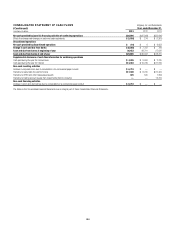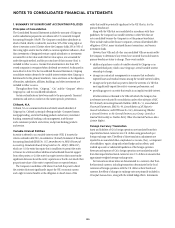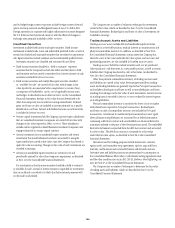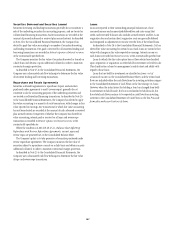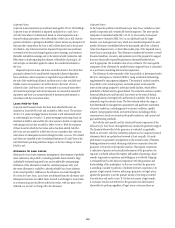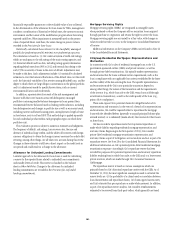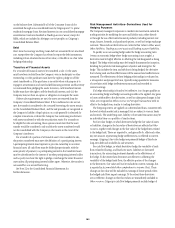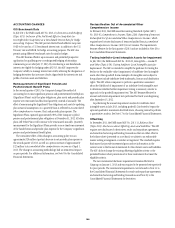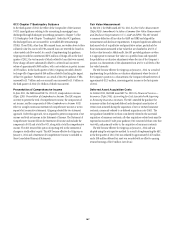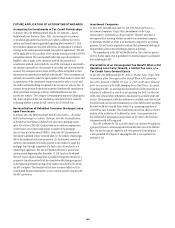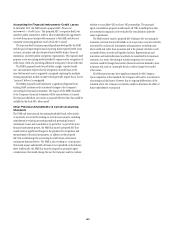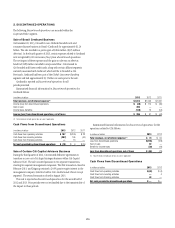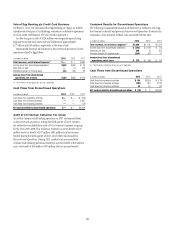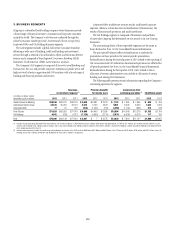Citibank 2013 Annual Report Download - page 181
Download and view the complete annual report
Please find page 181 of the 2013 Citibank annual report below. You can navigate through the pages in the report by either clicking on the pages listed below, or by using the keyword search tool below to find specific information within the annual report.163
on the balance sheet. Substantially all of the Consumer loans sold or
securitized through non-consolidated trusts by Citigroup are U.S. prime
residential mortgage loans. Retained interests in non-consolidated mortgage
securitization trusts are classified as Trading account assets, except for
MSRs, which are included in Mortgage servicing rights on Citigroup’s
Consolidated Balance Sheet.
Debt
Short-term borrowings and long-term debt are accounted for at amortized
cost, except where the Company has elected to report the debt instruments,
including certain structured notes at fair value, or the debt is in a fair value
hedging relationship.
Transfers of Financial Assets
For a transfer of financial assets to be considered a sale: (i) the assets
must have been isolated from the Company, even in bankruptcy or other
receivership; (ii) the purchaser must have the right to pledge or sell the
assets transferred or, if the purchaser is an entity whose sole purpose is to
engage in securitization and asset-backed financing activities and that entity
is constrained from pledging the assets it receives, each beneficial interest
holder must have the right to sell the beneficial interests; and (iii) the
Company may not have an option or obligation to reacquire the assets.
If these sale requirements are met, the assets are removed from the
Company’s Consolidated Balance Sheet. If the conditions for sale are not
met, the transfer is considered to be a secured borrowing, the assets remain
on the Consolidated Balance Sheet, and the sale proceeds are recognized as
the Company’s liability. A legal opinion on a sale generally is obtained for
complex transactions or where the Company has continuing involvement
with assets transferred or with the securitization entity. For a transfer to
be eligible for sale accounting, those opinions must state that the asset
transfer would be considered a sale and that the assets transferred would
not be consolidated with the Company’s other assets in the event of the
Company’s insolvency.
For a transfer of a portion of a financial asset to be considered a sale,
the portion transferred must meet the definition of a participating interest.
A participating interest must represent a pro rata ownership in an entire
financial asset; all cash flows must be divided proportionately, with the
same priority of payment; no participating interest in the transferred asset
may be subordinated to the interest of another participating interest holder;
and no party may have the right to pledge or exchange the entire financial
asset unless all participating interest holders agree. Otherwise, the transfer is
accounted for as a secured borrowing.
See Note 22 to the Consolidated Financial Statements for
further discussion.
Risk Management Activities—Derivatives Used for
Hedging Purposes
The Company manages its exposures to market rate movements outside its
trading activities by modifying the asset and liability mix, either directly
or through the use of derivative financial products, including interest-rate
swaps, futures, forwards, and purchased options, as well as foreign-exchange
contracts. These end-user derivatives are carried at fair value in Other assets,
Other liabilities, Trading account assets and Trading account liabilities.
To qualify as an accounting hedge under the hedge accounting rules
(versus an economic hedge where hedge accounting is not sought), a
derivative must be highly effective in offsetting the risk designated as being
hedged. The hedge relationship must be formally documented at inception,
detailing the particular risk management objective and strategy for the
hedge. This includes the item and risk that is being hedged, the derivative
that is being used and how effectiveness will be assessed and ineffectiveness
measured. The effectiveness of these hedging relationships is evaluated on
a retrospective and prospective basis, typically using quantitative measures
of correlation with hedge ineffectiveness measured and recorded in
current earnings.
If a hedge relationship is found to be ineffective, it no longer qualifies as
an accounting hedge and hedge accounting would not be applied. Any gains
or losses attributable to the derivatives, as well as subsequent changes in fair
value, are recognized in Other revenue or Principal transactions with no
offset to the hedged item, similar to trading derivatives.
The foregoing criteria are applied on a decentralized basis, consistent with
the level at which market risk is managed, but are subject to various limits
and controls. The underlying asset, liability or forecasted transaction may be
an individual item or a portfolio of similar items.
For fair value hedges, in which derivatives hedge the fair value of assets
or liabilities, changes in the fair value of derivatives are reflected in Other
revenue, together with changes in the fair value of the hedged item related
to the hedged risk. These are expected to, and generally do, offset each other.
Any net amount, representing hedge ineffectiveness, is reflected in current
earnings. Citigroup’s fair value hedges are primarily hedges of fixed-rate
long-term debt and available-for-sale securities.
For cash flow hedges, in which derivatives hedge the variability of cash
flows related to floating- and fixed-rate assets, liabilities or forecasted
transactions, the accounting treatment depends on the effectiveness of
the hedge. To the extent these derivatives are effective in offsetting the
variability of the hedged cash flows, the effective portion of the changes
in the derivatives’ fair values will not be included in current earnings, but
is reported in Accumulated other comprehensive income (loss). These
changes in fair value will be included in earnings of future periods when
the hedged cash flows impact earnings. To the extent these derivatives
are not effective, changes in their fair values are immediately included in
Other revenue. Citigroup’s cash flow hedges primarily include hedges of



